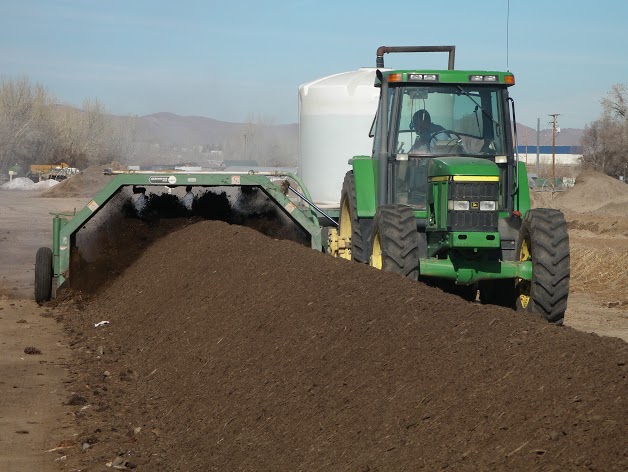There’s a lot of compost out there, and plenty of it is sub-par. This post warns you about the bad stuff and arms you with the knowledge you need to choose the good stuff–the best compost in Nevada for growing.
The Bad Stuff Cycle
There’s a pretty clear cycle keeping bad stuff on the market, and unfortunately it’s legal:
- Farmers around the country use powerful, chemical-laced herbicides and pesticides—bad stuff—on their crops
- Grazing animals eat these crops and ingest the bad stuff
- Animals do their business, depositing the bad stuff in their manure
- This bad stuff-laced manure gets made into compost (and usually too much of it)
- Farmers, composters and backyard gardeners buy the compost and put the bad stuff back in the ground
- Repeat!
Thank goodness it’s a little different in Nevada. Having Lake Tahoe as our next door neighbor means we have a few more restrictions on bad stuff, which makes it easier to know the source and quality of our materials. Here’s what you need to know.
Humus, Not Just a Pile of Manure
Manure is a starting ingredient in many composts. That does NOT mean you should go get a fresh pile of the stuff and chuck it around your garden. Some people think that’s a “pure” way to do things, but it’s actually—quite literally—just crap. (No apologies for that one).
Compost is called compost because it has completed the process of decomposition, meaning the manure’s organic matter has broken down into humus (not the kind you dip pita chips in …although it is a free country). In the eyes of a composter, manure isn’t even poop; it’s food for microbes to digest and turn into humus, the stuff that makes desirable, nourishing food for plants.
It’s another cycle. Animals eat plants and make manure, microbes eat the manure and make humus, plants eat humus and make nutritious fruits and veggies, repeat.
Buy Local
Quality compost is all about quality materials. You want to know where they came from and what they’ve been through. It’s just like food. You go to a farmers’ market because you want your tomatoes and carrots and kale and whatnot as fresh and local as possible because it’s better for you and better for the environment. We don’t have composters’ markets, but if we did, plants would definitely shop there. The same philosophy applies: buy local, and know the source and contents of your compost.
Be Sensible and Get Testy
How can you tell if a compost is good compost? Use your senses and investigate it!
Look. It should be kind of crumbly like your favorite coffee grounds. (See photo above). And since it’s decomposed, it should NOT look like what it used to be. If you can see wood, chunks of natural ingredients (or manure!), then it’s not fully composted. Also, although in your head it might look black, compost should really resemble a rich brown soil. Compost can become black, but only when it gets too hot and converts to ash (that’s bad).
Touch. It should be fine and smooth. If it broke down correctly, every ingredient should now be a pure form of humus. Just as you shouldn’t see the original ingredients, you shouldn’t feel them, either.
Smell. Lots of things in life don’t pass the smell test. Compost is something that should. And this one’s easy: if it smells bad, that’s because it is bad. And if it smells like crap … well, there you have it. Fully broken-down, high quality compost should smell rich and earthy, almost like dirt you’d find at a campsite. Just like look and touch, if it smells like something it used to be, it hasn’t decomposed.
Put Their Plants Where Their Compost Is!
The best way to tell if your supplier’s compost is any good is if you can see the results. If they can grow hundreds of starter plants in their own product, then you know they’ve got good stuff. Full Circle Soils & Compost does this throughout the entire year. We put our plants where our compost is (and vice versa).
That’s because our compost is not just good stuff, it’s amazing stuff. The best compost in Nevada (and maybe anywhere) for growing comes from Full Circle Soils & Compost. All of our products are locally produced, chemical-free, contain superior ingredients, are demonstrably successful, and are much, much more than a plain old pile of crap.
So don’t get the bad stuff. Come get the good stuff.




